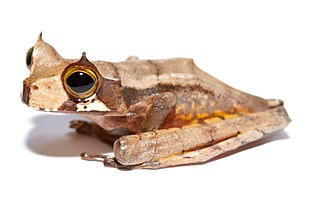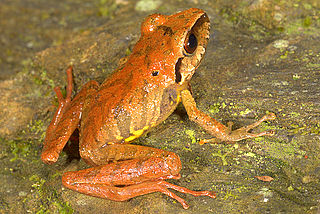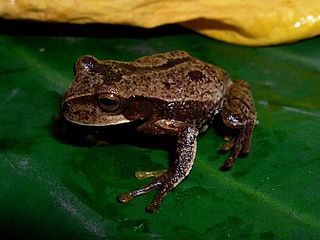
Gastrotheca is a genus of frogs in the family Hemiphractidae. They are found in Central America south of Costa Rica and in South America. Most species occur in the American Cordillera from southern Costa Rica to north-western Argentina. This genus makes up the bulk of marsupial frog diversity; formerly it was placed in the "Leptodactylidae" assemblage.

Allobates ornatus is a species of frog in the family Aromobatidae. It is endemic to northern Peru where it is only known from near its type locality, Tarapoto in the San Martín Province, on the eastern slopes of the Cordillera Oriental.
Dendropsophus aperomeus is a species of frog in the family Hylidae. It is endemic to Peru and occurs on the Amazonian slopes of the Andes in northern and central Peru. Common name Balzapata treefrog has been coined for it.
Pristimantis ceuthospilus is a species of frog in the family Strabomantidae. It is endemic to northern Peru and occurs on the western slopes of the Cordillera de Huancabamba and the Pacific slope of the Cordillera Occidental. There are also as yet unconfirmed records from southern Ecuador. The specific name ceuthospilus, from Greek keuthos ("hidden") and spilos ("spot"), refers to the yellow spots in the groin and thighs that remain hidden when the frog is sitting. Common name Wild's robber frog has been coined for it.

Pristimantis danae is a species of frog in the family Strabomantidae, sometimes known as Cuzco robber frog. It is found in the Andes between southern Peru and north-western Bolivia. It is named after the daughter of the author, Dana K. Duellman, who helped in collecting the frogs. Pristimantis reichlei, described in 2009, was previously confused with Pristimantis danae.
Pristimantis lindae is a species of frog in the family Strabomantidae. It is endemic to Peru and only known from Kosñipata Valley on the northeastern slopes of the Cadena de Paucartambo, a frontal range of the Cordillera Oriental in Cusco Region. The specific name lindae honors Linda Trueb, an American herpetologist and wife of William E. Duellman, the species describer. Nevertheless, common name Santa Isabel robber frog has been coined for this species.
Pristimantis salaputium is a species of frog in the family Strabomantidae. It is endemic to Peru and known from its type locality, the Río Cosñipata Valley, on the northeastern slopes of the Cadena de Paucartambo, a frontal range of the Cordillera Oriental in Cusco Region, and from the Apurímac River valley. Its range might extend into Bolivia. The specific name salaputium is Latin meaning "dwarf" and refers to the small size of this species. Common name river robber frog has been coined for it.
Pristimantis serendipitus is a species of frog in the family Strabomantidae. It is found in the Andes of northern Peru and adjacent southern Ecuador. The specific name refers to serendipitous discovery of this species: collection at the type locality was only made because the road was closed by an accident. Common name Colan Mountains robber frog has been proposed for this species.

Gastrotheca argenteovirens is a species of frog in the family Hemiphractidae. It is endemic to Colombia and occurs in the Colombian Massif, Cordillera Central, and Cordillera Occidental in the Quindío, Tolima, Valle del Cauca, Cauca, and Nariño Departments. Common name Popayan marsupial frog has been coined for it.
Gastrotheca atympana is a species of frog in the family Hemiphractidae. It is endemic to Peru and only known from its type locality in the Pampa Hermosa National Sanctuary, Junín Region. It lacks an external tympanum, hence the specific name atympana.

Gastrotheca dunni is a species of frog in the family Hemiphractidae. It is endemic to the northern part of the Cordillera Occidental in northern Antioquia, Colombia. The specific name dunni honors Emmett Reid Dunn, an American herpetologist. Common name Dunn's marsupial frog has been coined for it.

Gastrotheca excubitor is a species of frog in the family Hemiphractidae. It is endemic to southern Peru and occurs in the Amazonian slopes and crests of the Cordillera Oriental in the Cusco Region; records from the Cajamarca Region are likely erroneous. It is likely to include cryptic species. Common name Abra Acanacu marsupial frog has been coined for it.
Gastrotheca ochoai is a species of frog in the family Hemiphractidae. It is endemic to southern Peru and occurs in the interandean valleys on the eastern face of the Andes. The specific name ochoai honors Oscar Ochoa Mendieta, a biology professor from the National University of Saint Anthony the Abbot in Cuzco who helped the species descriptors during the field work. Common name Chilca marsupial frog has been coined for this species.
Gastrotheca pacchamama is a species of frog in the family Hemiphractidae. It is endemic to Peru and only known from the Ayacucho Region in the Cordillera Oriental.
Gastrotheca splendens is a species of frog in the family Hemiphractidae. It is endemic to Bolivia. The only precisely known record is from the eastern slopes of the Andes in the Amboró National Park, in the Santa Cruz Department. Only two specimens are known. Common name Schmidt's marsupial frog has been coined for this species, in reference to Eduard Oscar Schmidt who described the species.
Gastrotheca trachyceps is a species of frog in the family Hemiphractidae. It is endemic to the Cauca Department, Colombia, and is known from its type locality, Cerro Munchique in the Cordillera Occidental, and Vereda Santa Elena (Popayán) in the Cordillera Central. The specific name trachyceps is said to be derived from Greek trachy meaning "rough" and Latin ceps meaning "head", in reference to the rough appearance of the head. The proper word in Latin for head, however, is caput. The common name Cerro Munchique marsupial frog has been coined for it.
Gastrotheca zeugocystis is a species of frogs in the family Hemiphractidae. It is endemic to Peru and only known from its type locality on the Cordillera de Carpish, Huánuco Region. The specific name zeugocystis refers to the paired brood pouches in this species.
Lynchius nebulanastes is a species of frog in the family Strabomantidae. It is endemic to north-western Peru where it is known from the vicinity of its type locality, El Tambo, on the western slope of the Cordillera de Huancabamba, Piura Region. Common name Canchaque Andes frog has been coined for it.
Telmatobius ignavus is a species of frog in the family Telmatobiidae. It is endemic to the Cordillera de Huancabamba in the Department of Piura, Peru. Common name Piura water frog has been coined for it.
Phrynopus tribulosus is a species of frog in the family Strabomantidae. It is endemic to Peru and only known from its type locality near Oxapampa at 2,600 m (8,500 ft) asl, and from Santa Bárbara, in the Huancabamba District, Oxapampa, Pasco Region. It inhabits humid montane forests where individuals could be found deep within a mossy bank by day.






